Abstract
There is a marked difference in the structure of the arterial tree between epi- and endocardial layers of the human heart. To model these structural variations, we developed an extension to the computational method of constrained constructive optimization (CCO). Within the framework of CCO, a model tree is represented as a dichotomously branching network of straight cylindrical tubes, with flow conditions governed by Poiseuille's law. The tree is grown by successively adding new terminal segments from randomly selected points within the perfusion volume while optimizing the geometric location and topological site of each new connection with respect to minimum intravascular volume. The proposed method of “staged growth” guides the generation of new terminal sites by means of an additional time-dependent boundary condition, thereby inducing a sequence of domains of vascular growth within the given perfusion volume. Model trees generated in this way are very similar to reality in their visual appearance and predict diameter ratios of parent and daughter segments, the distribution of symmetry, the transmural distribution of flow, the volume of large arteries, as well as the ratio of small arterial volume in subendocardial and subepicardial layers in good agreement with experimental data. From this study we conclude that the method of CCO combined with staged growth reproduces many characteristics of the different arterial branching patterns in the subendocardium and the subepicardium, which could not be obtained by applying the principle of minimum volume alone. © 2000 Biomedical Engineering Society.
PAC00: 8719Uv, 8719Hh, 4760+i
Similar content being viewed by others
REFERENCES
Arts, T., R. T. I. Kruger, W. VanGerven, J. A. C. Lambregts, and R. S. Reneman. Propagation velocity and reflection of pressure waves in the canine coronary artery. Am. J. Physiol. 237:H469-H474, 1979.
Austin, Jr., R. E., N. G. Smedira, T. M. Squiers, and J. I. E. Hoffman. Influence of cardiac contraction and coronary va-somotor tone on regional myocardial blood flow. Am. J.Physiol. 266:H2542-H2553, 1994.
Bassingthwaighte, J. B., R. B. King, and S. A. Roger. Fractal nature of regional myocardial blood flow heterogeneity. Circ. Res. 65:578–590, 1989.
Chilian, W. M., S. M. Layne, E. C. Klausner, C. L. Eastham, and M. L. Marcus. Redistribution of coronary microvascular resistance produced by dipyridamole. Am. J. Physiol. 256:H383-H390, 1989.
Chilian, W. M. Microvascular pressures and resistances in the left ventricular subepicardium and subendocardium. Circ. Res. 69:561–570, 1991.
Fulton, W. F. M. Morphology of the myocardial microcircu-lation. In: Microcirculation of the Heart, edited by H. Tillmanns, W. Kübler, and H. Zebe. Berlin: Springer, 1982, pp. 15–25.
Fung, Y. C. Biomechanics: Motion, Flow, Stress, and Growth. New York: Springer, 1990, pp. 155–195.
Fung, Y. C. Biomechanics: Mechanical Properties of Living Tissues. New York: Springer, 1993, pp. 66–108.
Griffith, T. M. and D. H. Edwards. Basal EDRF activity helps to keep the geometrical configuration of arterial bifur-cations close to the Murray optimum. J. Theor. Biol. 146:545–573, 1990.
Hoffman, J. I. E. and J. A. E. Spaan. Pressure-flow relations in coronary circulation. Physiol. Rev. 70:331–390, 1990.
Hudlicka, O., M. Brown, and S. Egginton. Angiogenesis in skeletal and cardiac muscle. Physiol. Rev. 72:369–417, 1992.
James, T. N. Anatomy and pathology of small coronary ar-teries. In: Coronary Circulation: From Basic Mechanisms to Clinical Implications, edited by J. A. E. Spaan, A. V. G. Bruschke, and A. C. Gittenberger-DeGroot. Dordrecht: Mar-tinus Nijhoff, 1987, pp. 13–23.
Kalos, M. H., and P. A. Whitlock. Monte Carlo Methods. New York: Wiley, 1986, Vol. 1, pp. 40–48.
Kamiya, A. and T. Togawa. Optimal branching structure of the vascular tree. Bull. Math. Biophys. 34:431–438, 1972.
Karch, R., F. Neumann, M. Neumann, and W. Schreiner. A three-dimensional model for arterial tree representation, gen-erated by constrained constructive optimization. Comput. Biol. Med. 29:19–38, 1999.
Kassab, G. S., C. A. Rider, N. J. Tang, and Y.-C. B. Fung. Morphometry of pig coronary arterial trees. Am. J. Physiol. 265:H350-H365, 1993.
Kassab, G. S. and Y. C. B. Fung. The pattern of coronary arteriolar bifurcations and the uniform shear hypothesis. Ann. Biomed. Eng. 23:13–20, 1995.
Kassab, G. S., J. Berkley, and Y. C. B. Fung. Analysis of pig's coronary arterial blood flow with detailed anatomical data. Ann. Biomed. Eng. 25:204–217, 1997.
King, R. B., L. J. Weissman, and J. B. Bassingthwaighte. Fractal descriptions for spatial statistics. Ann. Biomed. Eng. 18:111–121, 1990.
LaBarbera, M. Principles of design of fluid transport systems in zoology. Science 249:992–999, 1990.
Lipowsky, H. H. and B. W. Zweifach. Methods for the si-multaneous measurement of pressure differentials and flows in single unbranched vessels of the microcirculation for rheo-logical studies. Microvasc. Res. 14:345–361, 1977.
Lipowsky, H. H., S. Usami, and S. Chien. In vivo measure-ments of the apparent viscosity and microvessel hematocrit in the mesentery of the cat. Microvasc. Res. 19:297–319, 1980.
Mayrovitz, H. N. and J. Roy. Microvascular blood flow: Evidence indicating a cubic dependence on arteriolar diam-eter. Am. J. Physiol. 245:H1031-H1038, 1983.
Murray, C. D. The physiological principle of minimum work. I. The vascular system and the cost of blood volume. Proc. Natl. Acad. Sci. US 12:207–214, 1926.
Murray, C. D. The physiological principle of minimum work applied to the angle of branching of arteries. J. Gen. Physiol. 9:835–841, 1926.
Neumann, F., M. Neumann, R. Karch, and W. Schreiner. Visualization of computer-generated arterial model trees. In: Simulation Modelling in Bioengineering, edited by M. Cer-rolaza, D. Jugo, and C. A. Brebbia. Southampton, U.K.: Computational Mechanics, 1996, pp. 259–268.
Neumann, F., W. Schreiner, and M. Neumann. Computer simulation of coronary arterial trees. Adv. Eng. Software 28:353–357, 1997.
Papoulis, A. Probability, Random Variables, and Stochastic Processes. New York: McGraw-Hill, 1981, pp. 279–332.
Pries, A. R., T. W. Secomb, T. Geáner, M. B. Sperandio, J. F. Gross, and P. Gaehtgens. Resistance to blood flow in microvessels in vivo. Circ. Res. 75:904–915, 1994.
Rosen, R. Optimality Principles in Biology. London: Butter-worth, 1967, pp. 40–60.
Schreiner, W. Computer generation of complex arterial tree models. J. Biomed. Eng. 15:148–149, 1993.
Schreiner, W., and P. Buxbaum. Computer-optimization of vascular trees. IEEE Trans. Biomed. Eng. 40:482–491, 1993.
Schreiner, W., M. Neumann, F. Neumann, S. M. Roedler, A. End, P. Buxbaum, M. R. Müller, and P. Spieckermann. The branching angles in computer-generated optimized models of arterial trees. J. Gen. Physiol. 103:975–989, 1994.
Schreiner, W., F. Neumann, M. Neumann, A. End, S. M. Roedler, and S. Aharinejad. The influence of optimization target selection on the structure of arterial tree models gen-erated by constrained constructive optimization. J. Gen. Physiol. 106:583–599, 1995.
Schreiner, W., F. Neumann, M. Neumann, A. End, and M. R. Müller. Structural quantification and bifurcation symmetry in arterial tree models generated by constrained constructive optimization. J. Theor. Biol. 180:161–174, 1996.
Schreiner, W., F. Neumann, M. Neumann, A. End, and S. M. Roedler. Anatomical variability and functional ability of vas-cular trees modeled by constrained constructive optimization. J. Theor. Biol. 187:147–158, 1997.
Schreiner, W., F. Neumann, R. Karch, M. Neumann, S. M. Roedler, and A. End. Shear stress distribution in arterial tree models, generated by constrained constructive optimization. J. Theor. Biol. 198:27–45, 1999.
Sherman, T. F. On connecting large vessels to small: The meaning of Murray's law. J. Gen. Physiol. 78:431–453, 1981.
Spaan, J. A. E. Coronary diastolic pressure-flow relation and zero flow pressure explained on the basis of intramyocardial compliance. Circ. Res. 56:293–309, 1985.
Spaan, J. A. E. Coronary Blood Flow: Mechanics, Distribu-tion, and Control. Dordrecht: Kluwer Academic, 1991, pp. 37–67.
Suwa, N., T. Niwa, H. Fukasawa, and Y. Sasaki. Estimation of intravascular blood pressure gradient by mathematical analysis of arterial casts. Tohoku J. Exp. Med. 79:168–198, 1963.
Uylings, H. B. M. Optimization of diameters and bifurcation angles in lung and vascular tree structures. Bull. Math. Biol. 39:509–520, 1977.
VanBavel, E. and J. A. E. Spaan. Branching patterns in the porcine coronary arterial tree: Estimation of flow heterogene-ity. Circ. Res. 71:1200–1212, 1992.
Van Beek, J. H. G. M., S. A. Roger, and J. B. Bassingth-waighte. Regional myocardial flow heterogeneity explained with fractal networks. Am. J. Physiol. 257:H1670-H1680, 1989.
West, G. B., J. H. Brown, and B. J. Enquist. A general model for the origin of allometric scaling laws in biology. Science 276:122–126, 1997.
Woldenberg, M. J. and K. Horsfield. Relation of branching angles to optimality for four cost principles. J. Theor. Biol. 122:187–204, 1986.
Wüsten, B., D. D. Buss, H. Deist, and W. Schaper. Dilatory capacity of the coronary circulation and its correlation to the arterial vasculature in the canine left ventricle. Basic Res. Cardiol. 72:636–650, 1977.
Zamir, M. Optimality principles in arterial branching. J. Theor. Biol. 62:227–251, 1976.
Zamir, M. The role of shear forces in arterial branching. J. Gen. Physiol. 67:213–222, 1976.
Zamir, M. Shear forces and blood vessel radii in the cardio-vascular system. J. Gen. Physiol. 69:449–461, 1977.
Zamir, M., J. A. Medeiros, and T. K. Cunningham. Arterial bifurcations in the human retina. J. Gen. Physiol. 74:537–548, 1979.
Zamir, M. and H. Chee. Branching characteristics of human coronary arteries. Can. J. Physiol. Pharmacol. 64:661–668, 1986.
Zamir, M. and H. Chee. Segment analysis of human coronary arteries. Blood Vessels 24:76–84, 1987.
Zamir, M. Distributing and delivering vessels of the human heart. J. Gen. Physiol. 91:725–735, 1988.
Zamir, M. Flow strategy and functional design of the coro-nary network. In: Coronary Circulation: Basic Mechanisms and Clinical Relevance, edited by F. Kajiya, G. A. Klassen, J. A. E. Spaan, and J. I. E. Hoffman. Tokyo: Springer, 1990, pp. 15–40.
Author information
Authors and Affiliations
Rights and permissions
About this article
Cite this article
Karch, R., Neumann, F., Neumann, M. et al. Staged Growth of Optimized Arterial Model Trees. Annals of Biomedical Engineering 28, 495–511 (2000). https://doi.org/10.1114/1.290
Issue Date:
DOI: https://doi.org/10.1114/1.290




